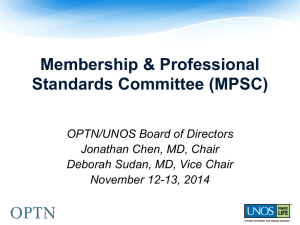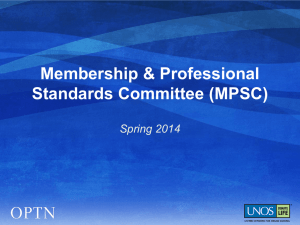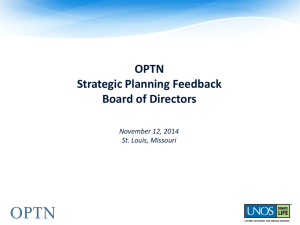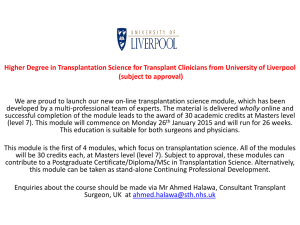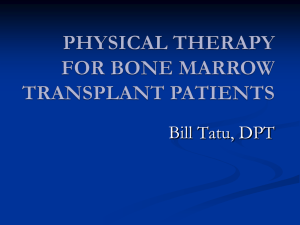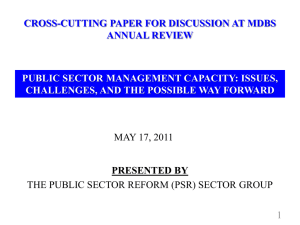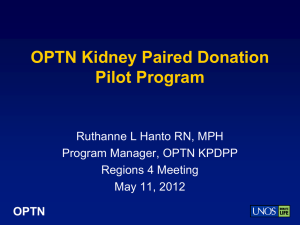Designing Systematic and Center-Specific Metrics to Foster Innovation
advertisement
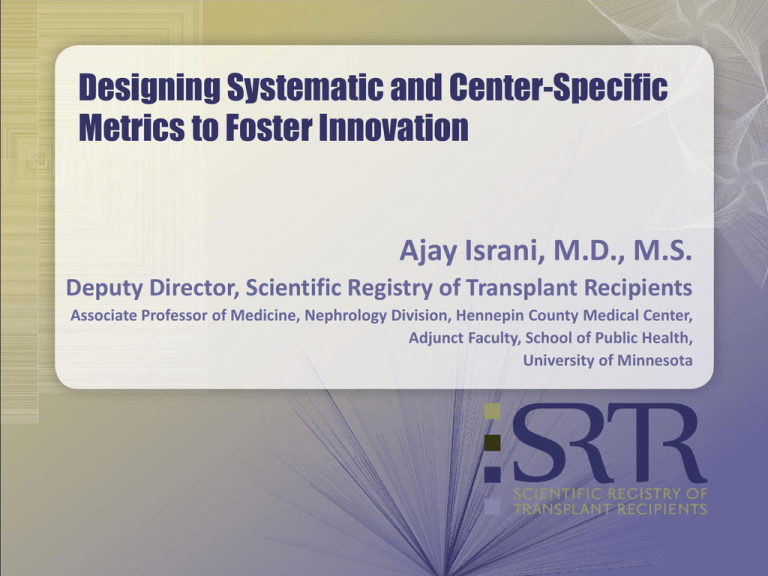
Designing Systematic and Center-Specific Metrics to Foster Innovation Ajay Israni, M.D., M.S. Deputy Director, Scientific Registry of Transplant Recipients Associate Professor of Medicine, Nephrology Division, Hennepin County Medical Center, Adjunct Faculty, School of Public Health, University of Minnesota Disclosure Information AASLD/ ILTS Transplant Course Ajay Israni, MD, MS • I have no financial relationships to disclose and • I will not discuss off label use and investigational use in my presentation 2 Outline • Introduction to the Scientific Registry of Transplant Recipients (SRTR) • Use of Program Specific Reports (PSRs) and OPOSpecific Reports (OSRs)to Foster Surgical Innovation • Program Specific Reports: Futility vs. Innovation • Program Specific Reports: Fostering Randomized Trials 3 Outline • Introduction to the Scientific Registry of Transplant Recipients (SRTR) • Use of Program Specific Reports (PSRs) and OPOSpecific Reports (OSRs)to Foster Surgical Innovation • Program Specific Reports: Futility vs. Innovation • Program Specific Reports: Fostering Randomized Trials 4 Role of the SRTR in Organ Transplantation Secretary of HHS HRSA DOT OPTN CMS Transplant Centers SRTR --------- STAC OPO’s Candidates & Recipients Living Donors 5 Investigators & the Public History of SRTR Contractors 2010 – present: Minneapolis Medical Research Foundation Prior to 2000: UNOS 2000-2010: Arbor Research Collaborative for Health 6 SRTR Senior Staff Biostatistics and Epidemiology Operations Director: Jon Snyder, PhD Biostatistics: Nicholas Salkowski, PhD, Jiannong Liu, PhD SRTR Director: Bertram Kasiske, MD Deputy Director: Ajay Israni, MD, MS Kidney Arthur Matas, MD Dorry Segev, MD Liver-Intestine Ray Kim, MD Jack Lake, MD Pancreas Raja Kandaswamy, MD Lung Maryam Valapour, MD Marshall Hertz, MD Heart Monica Colvin-Adams, MD Health Services Mark Schnitzler, PhD 7 Histocompatibility Howard Gebel, PhD Pediatrics Jodi Smith, MD Simulated Allocation Modeling Diwakar Gupta, PhD Sommer Gentry, PhD Dorry Segev, MD Academic Organizational Chart HCMC/ University of Minnesota U of Minnesota Johns Hopkins HCMC/ University of Minnesota Stanford U U of Minnesota U of Minnesota U of Minnesota Emory U of Minnesota U of Washington U of Minnesota Naval Academy Johns Hopkins St Louis U 8 SRTR Activities as per Final Rule Reporting Requirements …data shall include the following measures of inter-transplant program variation: risk-adjusted total life-years pre- and post-transplant, risk-adjusted patient and graft survival rates … risk-adjusted waiting time, and risk-adjusted transplantation rates, …as well as data regarding patients…who were inappropriately kept off a waiting list or retained on a waiting list. » Final Rule implemented in 2000 9 Role of the SRTR in Quality Improvement: Creating Program Specific Reports (PSR) Other Data OPTN Data SRTR UM-KECC PSR PSR Other CQI Tools RFI OPTN CMS OPTN MPSC Public Release 10 Center Only Insurance Provider Outline • Introduction to the Scientific Registry of Transplant Recipients (SRTR) • Use of Program Specific Reports (PSRs) and OPOSpecific Reports (OSRs)to Foster Surgical Innovation • Program Specific Reports: Futility vs. Innovation • Program Specific Reports: Fostering Randomized Trials 11 Recommendations from the Consensus Conference on Transplant Program Quality and Surveillance Arlington, VA February 13-15, 2012 I.4. Provide transplant centers with tools like the cumulative sum (CUSUM) technique and tools to perform subgroup analysis to facilitate Quality Assessment and Performance Improvement. 13 CUSUM: Released Monthly to All Transplant Programs since July 2013 14 CUSUM Recipient Survival Reports: Selecting the Time Period • Sliders on the bottom of the figure can limit the view to a specific time period 15 II.2. Identify centers that manage high-risk patients and donors well 16 Examples • Which programs transplant high MELD patients? • OPTN Liver Committee: − Which programs utilize DCD organs? − Determine which programs have superior post-transplant outcomes, including both graft and patient survival, with primary DCD liver transplants . Compare Practices at Best Centers Utilizing DCDs • There were 84 centers having at least 1 DCD transplant in the 1- and 3-year analyses. • Results only show the centers having performed at least 9 DCD transplants in the top 20 lists Comparison of practices at best centers may require validation by reviewing practices at centers with poor outcomes • New OPO-Specific Reports (OSRs) First Released: January 2014 Spring 2014 Release: June 17, 2014 Observed/ Expected, Adjusted Yield by Organ, 12/1/201112/31/2012 27 OPOs 22 33 31 OPOs 36 25 31 29 30 27 29 28 20 Israni et al., WTC, 2014 Where are the Livers Going? How far? 21 Outline • Introduction to the Scientific Registry of Transplant Recipients (SRTR) • Use of Program Specific Reports (PSRs) and OPOSpecific Reports (OSRs)to Foster Surgical Innovation • Program Specific Reports: Futility vs. Innovation • Program Specific Reports: Fostering Randomized Trials 22 Adjusting for risk: What is the right balance? Too Much Not Enough Futile Transplants Recipient Access Organs Donor Utilization 23 II.3. Collect more reliable organ-specific data on coronary heart disease (e.g. revascularizations), peripheral vascular disease (e.g. revascularizations and amputations),diabetes mellitus, ZIP code socioeconomic status, donor risk and ventricular assist devices 24 Overview of Data Advisory Committee (DAC) Charge/Functions • The DAC will seek broad input in developing a long term vision for the OPTN/SRTR data including: − process for the identification of OPTN data, − methods of collection, − types of products to be supported • Advise the OPTN Board of Directors on collecting data − pertinent to the operation of the OPTN & SRTR and − further the state-of-the-art in SOT including − continuous quality and patient safety improvements 25 Data Advisory Committee Members Name Role Name Role Charles Alexander Chair Maryl Johnson Member Joseph Kim Vice-Chair Alan Leichtman Member Sandy Feng * Member Richard Hasz Member Stuart Sweet Member Alexandra Glazier Member Jesse Schold Member Robert Merion* Member Yael Coppleson Member Mike Peterson Member James Wynn Member Monica Lin HRSA Ex Officio Ian Jamieson Member Shannon Dunne HRSA Ex Officio Support staff from the UNOS & the SRTR 26 Outline • Introduction to the Scientific Registry of Transplant Recipients (SRTR) • Use of Program Specific Reports (PSRs) and OPOSpecific Reports (OSRs)to Foster Surgical Innovation • Program Specific Reports: Futility vs. Innovation • Program Specific Reports: Fostering Randomized Trials 27 II.1. Consider protecting innovation by excluding patients who are in approved protocols from PSR models in identifying underperforming centers 28 Report of a Consensus Conference on Transplant Program Quality & Surveillance • Failure to adequately account for risk in PSRs may discourage centers from using innovative treatments. • Establishing a national body, e.g. an ad hoc subcommittee of the MPSC, to approve innovative treatment protocols that warrant special consideration • Ad hoc subcommittee would prospectively review and approve protocols and/or individual patients for exclusion: − Process should be transparent; the numbers of patients excluded and the reasons for exclusion should be available for each transplant center − Outcomes for patients treated under this exclusion should be reported separately Kasiske, et al. Am J Transplant 2012; 12:1988 29 OPTN/UNOS Ad Hoc Committee on Program-Specific Reports Report to the Board of Directors June 24-25, 2013 Richmond, VA John R. Lake, MD, Chair OPTN/UNOS Ad Hoc Committee on PSRs Committee Role Support Staff Org. John R. Lake* Chairman Christopher McLaughlin HRSA Sandy Feng* Member Monica Lin HRSA Tom Gonwa Member Bertram L. Kasiske SRTR Ken Andreoni Member Jon Snyder SRTR Larry Hunsicker Member Nicholas Salkowski SRTR Robert Merion* Member David Zaun SRTR Jennifer Milton Member Tabitha Leighton SRTR Ron Potts Member John Roberts UNOS Pres. Thomas Hamilton Member (CMS) Jacqueline O’Keefe UNOS Karen Tritz Member (CMS) Erick Edwards UNOS Robert Hunter UNOS Kasiske, et al. Am J Transplant 2012; 12:1988 David UNOS 31 Kappus Report from OPTN/UNOS Ad Hoc Committee on PSRs • There was not a lot of support for using a standard risk patient profile. • More support for allowing the centers to define which patients are high-risk outside of the criteria currently collected for the PSR because centers can identify high risk patients better than the model. • Subcommittee discussed rolling out the self-identification of high risk patients as a pilot program first, but this option requires more discussion - not yet a formal recommendation. • But, the Subcommittee noted that there are constraints with the selfidentification of high risk patients, including variation among centers regarding what variables indicate high risk, and requiring additional data collection. 32 Possible PSR Exclusion: Questions a. How is a protocol agreed upon as being acceptable for exclusion? b. Does a protocol need to have scientific merit? c. Who decides? d. Does there need to be some type of DSMB and stop rules? e. Is there a need for a consent process, who approves the consent? f. Is there a limitation to the size of the center that can participate? g. Is there a limitation on the number of patients (% of population) that can be entered in by a center? h. How can “gaming” be avoided? 33 Possible PSR Exclusion: Path Forward • There would need to be a “true” research protocol, e.g. a government-registered clinical trial. • The MPSC would need to determine whether the experimental protocol qualified for exclusion. • PSRs would start with the total cohort, but patients in research protocols would be excluded. • Centers would choose whether to exclude patients. • Data forms would collect information from the experimental protocols at the time of transplant. 34 Conclusion • Possible to have Program Specific Metrics to Foster Innovation − Utilize metrics to identify innovative centers − Compare best practices at centers and OPOs, − Utilize Data Advisory Committee to identify new OPTN data, collection methods − Exclude patients who are in approved protocols from PSR 35 Acknowledgments SRTR • • • • • Bertram Kasiske, MD Jon Snyder, PhD, MS Nicholas Salkowski, PhD Jack Lake, MD SRTR Analysts and Liaisons 36
